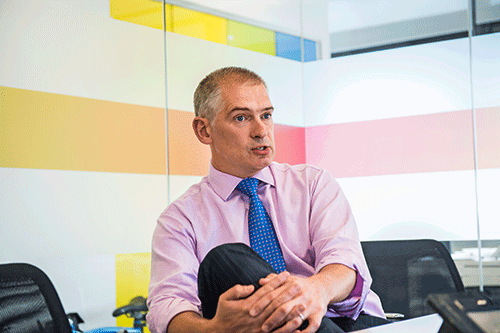 Read the peer reviews on the article.
Read the peer reviews on the article.
York. A city of narrow lanes. A Roman city. A city of chocolate. A railway city.
Its elegantly curved trainshed houses services for London and Scotland, the seaside at Scarborough, the tearooms of Harrogate and the grit of the Pennines.
Tucked behind an arch cut through the city walls, and just beyond a small brick railway hut, is Network Rail’s local headquarters. Its modernity stands in contrast to the city’s railway heritage.
From his desk on the fourth floor, Route Managing Director Rob McIntosh is determined to change the way NR works. He wants a company that listens to local communities. He wants a company that helps communities. He wants a railway that is the community’s - even though it’s Network Rail that remains its custodian.
McIntosh has been in the post since January, taking over from Phil Verster, who moved north to head an alliance between ScotRail and Network Rail. His appointment coincided with NR Chief Executive Mark Carne making changes to NR’s structure that pushed power from central headquarters down to the routes. Then Nicola Shaw published her review of NR’s long-term shape. She advocated devolution and more control of NR at regional level, which chimed with government policies to push responsibility down to local politicians. No longer would London decide what was best for Leeds.
Yet McIntosh is clear about the wider relevance of Shaw’s work: “The passenger doesn’t care what Shaw says. It’s ‘Nicola who?’ as far as they’re concerned. They just want to get on a train when they expect they should and get off that train when and where they bought a ticket for. As an industry we struggle to keep sight of that sometimes.”
That’s a refreshing view… concentrate on the passenger (or freight shipper) rather than the report itself. McIntosh continues: “The Shaw report was initiated to try and understand what we needed to do with NR, to take it forward and make it better. The passenger cares simply about value for money, and getting on the train when they want to and getting off where and when they want to. The industry that sits behind that is incredibly complicated.
“So, the product is fairly simple - a safe and reliable railway. But the industry that delivers that is incredibly complicated. The Shaw report was initiated to try to understand what we might do with the industry, as well as NR, to make that better.”
Yet, if the railway industry was to be honest, there wasn’t much in Shaw that it didn’t know deep down already. After all, her first recommendation was that rail users should be placed at the heart of the railway. That she had to say this did not reflect well on the railway.
McIntosh agrees that while there was little new in Shaw’s report, there was a change of direction, as he explains: “The Shaw report looked very much like the direction of travel that Mark Carne and Sir Peter Hendy had already set out on. In fact, it really underlined the direction of travel.
“The one aspect of the Shaw report that stands out that wasn’t in our strategy was the recommendation that there was a northern route. The Shaw report talks about greater devolution, more control, better alignment with customers, the skills agenda, diversity, inclusion, how do we deal with the ageing workforce - all things that we’d set out in our strategy anyway. But the northern route was not something that was in our plans at that time.”
Northern England’s railways have always been split, but the nature of that split changed radically nearly a century ago. Before 1923, railway companies straddled the Pennines - the Lancashire & Yorkshire Railway did exactly what its name describes, with its route through the Calder Valley; the London and North Western Railway crossed the ‘big hill’ a little further south at Standedge; the Great Central crossed at Woodhead; and the Midland Railway took a route that demanded two long tunnels, one at Cowburn and one at Totley.
The routes didn’t change when the government grouped them and Britain’s other railway companies into four. But instead of several railway companies crossing the Pennines in their own corridors, grouping brought an east-west split with the London, Midland and Scottish Railway to the west and the London and North Eastern Railway to the east. Of course, it wasn’t this simple. The LMS took most of the LYR, LNWR and MR (and their routes under the Pennines), while the LNER took the GCR and its Woodhead tunnel.
Creation of British Railways in 1948 changed things again. As far as northern England was concerned the LMS become the London Midland Region and the northern half of the LNER became the North Eastern Region. It was later merged into the Eastern Region.
The boundary sat just west of Hebden Bridge on the old LYR route, and it remains the boundary between McIntosh and his counterpart Martin Frobisher. BR’s boundary sat just east of Standedge Tunnel on that route - today NR’s sits at the west end of the tunnel. On the Woodhead the BR regional boundary sat east of the tunnel - today it doesn’t exist (the line closed in 1981). Trains on the old Midland road crossed the regional boundary just before plunging into Totley Tunnel as they ran west. It remains there today.
So does it matter where boundaries lie?
“I think it does matter, personally,” says McIntosh. He then pauses for thought: “But what that means is a matter of perspective, so we have route boundaries designed upon the operation of the railway and the legacy design of the railway. We still talk about up to London and down to the country. The railway is built around people coming to and from London, and that’s how it’s operated now.
“So it does matter where those boundaries are drawn. The important thing in the Shaw report is that people called for a northern route because of the structure of Network Rail. People called for a northern route because they found Network Rail a difficult organisation to deal with. So whatever we decide to do with our organisational boundaries and our structure lines, what we can’t afford not to do is address the underlying issues that make Network Rail very difficult to deal with if you’re an external stakeholder.”
That’s a comment likely to have heads nodding in council offices around Britain - indeed, from anyone who’s ever tried to engage with the national track owner to improve the network. NR has taken a centralised view of what’s best for the railway and what’s best for different parts of the country. McIntosh doesn’t pull his punches: “It’s very difficult to find one person that can deal with issues on your behalf. I’ve developed a phrase in Network Rail that I call the ‘accountability fog’, because accountability is interpreted and spread across many parts of the organisation and so it becomes really difficult to say ‘there is the person that is accountable for whatever the subject matter might be’.
“It’s compounded by our legacy control hierarchy. Network Rail, quite rightly, does a lot of its assurance by control. It controls decisions centrally, and what that does is it makes the accountability difficult.”
When NR took over from Railtrack’s shambles in 2002 it needed to tightly grip the network, and imposed central discipline. Railtrack’s network had been collapsing under a welter of speed restrictions caused by gauge corner cracking, the track fault that lay at the heart of October 2000’s fatal derailment at Hatfield. Overnight, gauge corner cracking went from being an obscure term used by track engineers to national recognition.
What made matters worse was the different reactions from each of Railtrack’s zones. In Scotland, for example, the zone simply shut the West Coast Main Line north of Carlisle. As ScotRail Managing Director Alastair McPherson said at the time: “We are Railtrack’s biggest customer, and if this is their idea of customer service it certainly isn’t mine.”
NR needed an iron grip to rescue and restore the railway. Largely it has succeeded, and it now needs to move forwards. “The organisation is much more mature now and much more balanced, and the stakeholder needs are very different. So as the political with a capital ‘p’ devolution pushes forward, there’s less control from London and therefore a greater desire to deal with decision-makers locally,” argues McIntosh.
Devolution has been gathering speed within NR over the past few years, to the extent that McIntosh is happy to claim that he knows what a devolved route should look like: “Very simply, it looks like an organisation that can respond to the needs of its customers and the economies and communities that it serves.”
But who is Network Rail’s customer?
There is another pause: “It depends on your definition of customer, and it’s a complicated world. You could say your customer is someone who pays you money for something - we have operating companies that pay us money for something and they are our customers. But it’s not a conventional customer relationship. Certainly, if you speak to any operating company they will tell you they don’t feel like a customer when they engage with NR. I see that in some of the legacy behaviours with our people. They don’t treat them like customers because it’s not how it’s been in the past.
“You could argue, and some people have said in the past, that ORR was our customer because the ORR effectively set our targets for us and we responded. And the organisation behaved and responded in a way to those customer targets or those targets set by the regulator, rather than by its customers. The phrase that I use is that NR allowed itself to be managed by the regulator rather than regulated.”
What about the Department for Transport? After all, it buys considerable rail enhancements from NR.
“They’re a funder not a customer. There’s a difference between being a funder and customer.”
But DfT buys upgrades?
McIntosh speaks slowly: “They fund upgrades for us.”
But DfT says what it wants, gives NR money, and expects to see a product delivered. That sounds like a customer.
“They are not the end user of that…”
Only in as much as DfT doesn’t directly run trains. But it specifies franchises on the back of enhancements it has bought from Network Rail. This is a very difficult area for NR. It needs to face passengers and freight shippers, yet the reality remains that government pays for almost all of the railway’s improvements. DfT also owns NR and the Transport Secretary appoints its chairman.
McIntosh moves to safer ground: “The relationship with the DfT is one that’s getting much better, particularly with regard to the enhancements portfolio. The Bowe report pointed out some home truths to both NR and the Department about how the ‘once in a generation’ investment portfolio was not being managed. As a result of that, we have a very good governance structure in place and a good working relationship with the Department which is unlike anything I’ve seen in my career, in terms of the maturity of the approach the Department is taking.”
McIntosh is in his stride now: “The other part, when you said ‘is NR ready for devolution?’, is that NR is culturally in a state of change in a good way. NR came from a place where we were effectively self-funding, marshalled by a regulator. So we would go and borrow the money that we thought was needed to maintain, operate and enhance the railway, and we do that with the DfT and with the regulator.
“They were the three parties, and consequently one of the bits of feedback I get from local stakeholders is that NR would go and tell the stakeholders what they can or can’t have. What they won’t do is work with them to understand what it is they really need and how we might realise it. That’s quite subtle, but it’s a very different interaction.
“We’re doing a lot of work with the leader of Leeds City Council, because it is very keen to work with us to redevelop Leeds City station as the catalyst for a much wider redevelopment of the South Bank area. The first person that it got from NR (some years ago, I might add) came up and the opening line was: ‘You can’t have a St Pancras or a King’s Cross’.
“So immediately, they are turned off. Which is just wrong. The reason for making that point is that we’re going through a change where we realise that NR was nothing more than the custodian of what I believe is the country’s most valuable asset - its railway. I would say that because I’ve been in it for most of my career, but it is an incredibly valuable asset.
“But it’s a public asset - NR just happens to be the custodian of it at any one point in time. So, rather than being an organisation that does what it thinks it should do with that public asset, NR needs to make sure that that public asset best serves the communities and economies. Or is best managed and enhanced to serve the needs of communities and economies that it serves. That’s a big change from where Network Rail has been.”
There’s a nagging contradiction here. NR cannot claim that government (national) is not a customer and then paint government (regional or local) as a customer. If, in future, Leeds City Council can specify and fund NR to deliver railway improvements, then it will be just as much of an NR customer as DfT is today for specifying and funding enhancements.
The reality remains that many bodies pay NR and expect a product in return. NR must treat them all as customers, while not forgetting that in many cases those bodies are intermediates between NR and the ultimate customers - passengers, freight shippers and taxpayers.
Unless someone has a spare £500 million, then the person who told Leeds that it couldn’t have a King’s Cross or a St Pancras was simply being realistic. Rebuilding Leeds was one of Railtrack’s successful projects, costed at £165m back in 1999, and it transformed the station.
McIntosh worked on the project: “We rebuilt it for a quarter of the footfall it now has. We’ve just opened Leeds Southern Entrance at the turn of the year. So I think there is plenty of… well, June 24 might have changed things, but until June 24 there was plenty of investment out there. One of the key objectives I have as a Route Managing Director in a devolved route is to realise private investment onto the railway. And even from the very preliminary enquiries that we’ve made, there are plenty of people who would like to invest.
“It’s about firstly doing it on an equitable risk basis, and what a reasonable amount of risk is for a commercial organisation to take versus what NR and the Government can underwrite. But also who enables that investment. When someone wants to come and invest in the railway at the moment, it’s a really difficult experience for them. We have a team of guys called ‘asset protection’ - so by definition they’re there to protect NR’s assets, not enable that investment, because that’s what we incentivise them to do. One of the things we’re considering is taking that team and calling them ‘asset enabling and investment’, so that we can make it easier for investment to happen in and around the railway.”
Asked why an investor would be interested in Network Rail, given its disappointing record in delivering major projects such as the very late-running Great Western electrification project, McIntosh argues: “You’re jumping to the conclusion that NR has to deliver that investment.
“You need to explore how that would happen. NR should not be the default setting for delivering the investment. We have a huge investment portfolio at the moment. That investment portfolio’s been re-baselined, been refocused under the Hendy review, and we have to deliver against that commitment.
“Anything that sits outside of that, we need to be exploring different models. You first of all need to look at the nature of the investment that you want to do. So at one end of the spectrum you can have Digital Railway, or you can come back round and say ‘let’s look at the Brent Cross station development on the Midland Main Line’. You then have some of the things we’re looking to do with Leeds City Council in terms of station development, and then you have things like the York Central development.
McIntosh reckons that each will take a different way of working. A property developer might be happy with the risks of investing in Leeds station’s commercial side, but wouldn’t take the risk with anything that might shut the railway. That risk best lies with NR.
“As long as NR is an extended arm of the Government, then that should be underwritten by the Government via NR. But you need to explore and identify the opportunities and look at the best model for doing those,” he argues.
But that puts us back to risk of delivery, and that’s where NR’s track record isn’t good.
“Agreed,” he replies.
So what’s the answer? How does NR change that?
“I think that some people would put their money with NR. But it’s about how you have the relationship to look at each individual opportunity, because what somebody might be willing to invest in Digital Railway might be massively different to what we might want to do around Leeds. But we need to move away from NR’s delivery record and start to explore different delivery mechanisms.
“Because you’re right, NR recently has had a difficult delivery record. But up until (I guess) the problems we encountered last year we’d been doing very well. And I was part of projects organisation that was delivering those kind of commitments. Jobs like Borders, and before that Airdrie-Bathgate and some of the station remodellings like Nottingham - these things have gone well.”
It’s worth pointing out that while it’s true that those three projects went well, two of them were largely away from live railways, which made them considerably easier. Just a few miles south of York lies Doncaster, another railway town. NR is building a new platform (Platform 0), linked to the main station by a new footbridge. Passengers should have been using it last December, but it’s not finished and is likely to be a year late.
McIntosh concedes: “Doncaster is late for exactly the same reasons as things like the Great Western Electrification Programme being late, in that the discipline around the early gateways of projects wasn’t adhered to. So Doncaster was allowed to go through its GRIP3 when it wasn’t suitable to do that. Only when you start applying the rigour and discipline to those early gateways will you begin to recover the position.”
For Doncaster, the problems centred on associated changes to signalling, particularly a plan to introduce bi-directional signalling south of the station. McIntosh notes: “The reality with Doncaster is that when they went through GRIP3, no one had properly understood the significance of the signalling changes associated with Doncaster, and the complexity of the work you’d have to do in the Westpacs and the relay room.”
He explains the wider problem with another example. “At the end of my first week as Route Managing Director, January 9 this year, we had a GRIP3 gateway for the King’s Cross remodelling, which is the biggest intervention we’re going to do on the LNE route probably for a generation. The team presented to me what they thought was a GRIP3 that was ready to go - they were saying we need to go through this gateway, we need to hit 2019 and it needs to be done.
“And very quickly I concluded that it wasn’t in a fit state to go through a GRIP3 gateway. So I didn’t allow it. The impact of that is we’ve delayed that project for a year. But it’s the right thing to do, because it’s that lack of discipline and difficult decisions at that point in a project’s lifecycle that allows things like Doncaster to happen.”
It is the checks and balances of project gateways that has been absent in previous NR schemes, if McIntosh is right. He’s keen that projects on his patch are thoroughly checked by those with the experience to find the problems, which contrasts with the view of Francis Paonessa, who heads NR’s infrastructure projects division. Speaking in February 2015 after major engineering overruns at Paddington and King’s Cross over Christmas 2014, Paonessa said that it wouldn’t have made any difference if more people had checked the plans.
NR used a technique known as quantified scheduled risk assessment (QSRA), which takes the results of previous projects to estimate the probability of a future project running as planned. Looking back over King’s Cross, Paonessa said: “We retrospectively went back and looked at the plan that we had, and even if we attended the QSRA with a hundred people, I personally would have been quite confident going into the plan that we had.”
McIntosh explains NR’s project problems: “It’s a lack of assurance. I’ve spent pretty much most of my career delivering projects, and as a project person you’re incentivised to deliver your project. What that does is sometimes creates a mindset where you push too hard for delivering a project and meeting your milestones. To counter that you need some assurance processes around your gateways to make sure that before your project moves from one state to another state, which in NR speak is GRIP, it’s fit and ready to do so. That’s where we’ve not been robust enough.”
His message is that there have not been enough checks to counter the natural optimism of project managers. He continues: “That’s no different to projects like Great Western electrification, which has the same issue on a grander scale. When Mark Carne went to the Public Accounts Committee, he talked quite openly that the project went into build status before its design was finished.”
Surely it’s obvious that you can’t build something before it’s designed?
“You convince yourself that you can build bits of it. That’s what happens. That’s why you need an assurance.”
He continues: “The discipline around project gateways is pretty widely known in any industry. And any project in any industry that’s ever got itself into bother is because it’s not managed that discipline around those gateways. Because, quite often, people don’t want to be told that you can’t hit that date.”
What makes McIntosh sure that there’s now enough emphasis on checking projects before they start?
“There are a few things. Nationally, there’s the enhancements delivery improvement programme, which is something we’ve worked up with the regulator under Malcolm Brindred, who is one of our non-execs. There are a number of improvements within that, not least a very robust peer review process. More locally, we’ve just installed discipline around the fact that projects won’t go through GRIP3 gateway until they come to my investment panel, where we will ask the very simple question.”
Having already rejected a major project such as the King’s Cross throat renewals, and added a year to its former 2019 deadline, McIntosh shows that he’s not going to be a pushover for any project manager who appears without a solid plan that can be delivered. But is McIntosh sure he has the right people to help?
“We’ve got… yes is the straightforward answer. The reason for my hesitation is that we should make sure that when we’re peer-reviewing Doncaster Platform 0, for example, the people who are peer-reviewing know what an intervention like that might mean. So somebody looking at Doncaster Platform 0 realises that attached to it is the introduction of bi-directional signalling, which is a very complicated piece of signalling work.
“So what we have to do is make sure that when you start a project, you look at the scope and ask who are the people with the experience and competence to understand it and get underneath the skin of it.”
Railway projects have also been complicated, needing a variety of pieces to fall correctly into place. They can be disrupted by the simplest of things - a key member of staff falling ill, high winds disrupting a crane, or cold weather freezing ballast into wagons. They can also be delayed by competing priorities taking essential kit elsewhere - there are only so many heavy lift cranes in the country, or high-capacity tampers fit for third rail use, for example.
Complexity also comes from doing many different things at the same time. NR certainly has plenty to do, and an impatient audience. So how can NR make its projects simpler to deliver?
McIntosh has plenty to say: “Let me give you an example - the Digital Railway, and in particular ETCS on the East Coast Main Line. One of the decisions I made when we postponed the implementation of King’s Cross was to also decouple European Train Control System and the remodelling. ETCS has a very different risk profile to that of the remodelling. But because they would both be done at the same time, they would be coupled together. But in doing that you were compounding the risk profile, so instead of 1+1=2 you had 1+1= about 7.”
Essentially, it was going to be too risky to install new signalling on a railway that was being rebuilt - the risk of one project or the other not being completed on time was too much. Yet there’s a cost in installing conventional signalling for the new King’s Cross layout that could be removed in only a few years.
“We’re now beginning the process of going back to the industry to consult on our ETCS programme on the East Coast Main Line. The important point I’m trying to make is that previously the programme was going to be done in parallel with us reconfiguring the East Coast Main Line with King’s Cross, Huntingdon to Woodwalton four-tracking, and Werrington dive-under. And the one thing I know from my own experience is trying to deliver something like ETCS on an unstable railway layout will cause a lot of pain.
“So the first thing we’re going to do with our ETCS programme is get a stable railway that’s ETCS and technology-ready, to then allow us to roll the technology on top. The shift from colour-light signalling to in-cab signalling is huge, culturally huge, on the railway. Then, when we’ve got that operating in a safe and reliable way, we can then begin to hone the solution to deliver some of the performance and capacity benefits that it can bring.
“So your question about how we can do things differently in the future is that we need to be realistic about how we implement the big changes on the railway - what can be done in what timeframes. And face up to some difficult tasks. There are a lot of MPs who keep telling me they can do things faster and better on the railway, and maybe they can have a go, but we need to be quite robust with our stakeholders when we’re setting these projects up. That’s one of the things we’ve not done in the past.”
The upgrades McIntosh mentions (Woodwalton and Werrington), and others such as York North Throat remodelling and freight loops between Northallerton and Newcastle, are set to unlock more capacity on the ECML. Virgin is keen to use that capacity to help pay its £3 billion premium to government. First is keen to use it to run London-Edinburgh open access services from 2021, for which it recently won permission from the Office of Rail and Road. Are they likely to be delivered in this Control Period (before 2019)?
“No, not those. But I think there’s a context to what was published and what was said in this Control Period. King’s Cross Throat is a renewals scheme which would have been delivered right at the end of this Control Period, and now will go into the next Control Period.
“Huntingdon to Woodwalton, Werrington, York North Throat, the freight loops further up the line - they were part of the connectivity fund. They were part of a fund that the DfT said NR and the industry should spend as they see fit. So those were projects that we’d progress in the Control Period, but not necessarily committed outputs. I think that message has got lost. I believe it was broadcast, but it was not emphasised enough. It wasn’t emphasised enough that we were talking about a fund that was given to the industry for it to consider how to spend.”
That’s disappointing news for those looking to see an improved ECML. McIntosh continues: “It’s been a very interesting exercise being part of that, because part of the reason we aren’t going to deliver as much in the Control Period as we probably originally planned to do is because it’s been very hard to get the industry to agree on what you might spend that money on. The industry is very complicated and each stakeholder has a different perspective and different needs. Trying to get the train operator and the freight operator to agree on what they need to do on the East Coast Main Line - other than completely separate from each other, which isn’t physically possible - is a real challenge.”
Back to his route and devolution. It’s clear this journey is just starting, but where would McIntosh see it by 2019, at the end of the current five-year Control Period?
“We want the route to be in a place where it can be independently regulated. We don’t underestimate the challenge that brings, but we see the route becoming very much devolved, being responsive to the needs of the communities, the Local Enterprise Partnerships, the councils, the combined authorities that we serve, and able to make decisions that serve those people.
“Back to the point on regulation, I don’t think it’s taking today’s regulation model and dividing it by eight routes and saying now regulate those eight routes in the same way that you regulated NR. I think we need to work with the regulator and the industry to say ‘how do you regulate a Network Rail route?’”
So if it’s not a simple division of today’s regulation, how does McIntosh see it being done?
“My thoughts now are that it would be dangerous to start defining how you might do it. We need to get together with the regulator and the stakeholders and begin to have the conversation, and go back to the first principles of what is regulation and who are the customers that we’re looking to protect in this thing, because I think that regulation is about protecting the customer but also the taxpayer.
“It’s about having that conversation with bodies like Transport for the North, which is running the TransPennine and Northern franchises. You have the combined authorities and you have quite progressive city councils like Newcastle or Leeds or York, all with a lot of dependency on the railway that Network Rail is a custodian of. They will have to have a view on how we are regulated in their interests. So I think we have to engage with everyone who’s involved, to start to define how we should be regulated. But it isn’t about how we’ve been regulated so far - I don’t think that’s the answer.”
That could lead to a different model for each route, with its attendant complications. This point has McIntosh thinking, and so he answers slowly: “That’s an interesting point… different regulation for different routes… so the routes are pretty different. They are different in their make-up, they are different in their railway, they are different in the age of their railway.
“The East Coast Main Line is without a doubt the one of the main arteries that’s had the least investment in recent years. We haven’t really done much with it. So I don’t think you need to regulate the route differently, I think we need to regulate the routes under a simpler framework that allows them to be responsive to the local needs of their routes.”
Whatever form devolution takes, it’s clear that the railway will need to change to better reflect local needs. Changing culture has always been harder than changing track layouts.
“When I talked earlier about the centralised hierarchical culture of Network Rail, part of that is that within the routes they are very much used to being done to. So culturally within the route a lot of my people are used to being told what they can and can’t do, rather than arguing very strongly for what they think is right.
“We’re on a journey of changing people’s behaviour in that respect, and starting to grab hold of what might be perceived as an old, centralised policy or issue that doesn’t suit our needs. This is what we need to be done more locally. So that’s about how people behave and about giving people leadership and some support, to start being bold and doing what they think is right rather than sometimes being used to being told what to do.
“On the projects side of things, the first thing I did when I became RMD was to create a new investment function. The old route organisation was set up (and is set up) to focus on the day-to-day operation of the railway and deliver our performance targets in line with our determination. That’s enough of a job in itself, I assure you. I didn’t appreciate how demanding that actually is.
“But we’re not set up to do anything else. All this stuff I’ve talked about - stakeholders, engagement and investment delivery and discipline - we’re not set up to do that. One of the first things I did was to create an investment function and put a senior person in charge of it.
“We’ve completely restructured our sponsorship organisation. There was one principal sponsor looking after all three of the main route programmes. Whether it’s Midland Main Line, East Coast Main Line or Trans-Pennine, it was just one principal sponsor. We now have three with teams underneath them, so we’ve pulled the bench strength up. We’re now turning our attention towards how we create a team that’s able to go out and attract and enable some of that external investment. We didn’t really have that before.”
This means that if local councils want rail projects, there will be an expectation that the money for them is local, too. Whether that’s taxpayers’ money or private money, it will come from local sources.
None of these important ideas will see light if NR doesn’t get to grips with day-to-day running. Latest statistics for NR’s share of delays for key operators on the route show 70% for Virgin Trains East Coast and 55% for Northern. This needs to improve, as McIntosh is acutely aware.
“We’ve spent the best part of an hour now talking about how we want to move forward as an industry, and I think there are some really exciting things we can do. I’m here because I really want to change the industry. I came to work for Network Rail because I could really see an opportunity at a time when we can really modernise how things are done. But you don’t get to do any of that unless you’re running the train services as they should be.
“So if I wake up in the morning and everything’s red… …and last week was a particularly red week, then that’s where you have to put your effort and your energy. You have to get it to a place where you can sustainably and safely deliver a reliable railway before you do any of this stuff.”
How does he plan to keep on top of the vital area?
“System thinking. The railway asset is a system. Where there’s a great opportunity is… that system has within it a number of single points of failure, and at any one time we need to be making sure that we understand the system status of any one of those single points of failure. Whether it’s fully robust and as it should be, or whether it’s partially degraded, or whether it’s in a quite difficult state, and therefore what mitigations we put around it to keep it going. We tend to manage the railway at a component or discipline level rather than at a system level. We don’t manage the asset as a system.
“I have a group of my engineers in with me on Wednesday, where we’re going to really make that concept come to life. There are four area directors that work for me - East Coast North, South, Central and East Midlands. Those guys don’t have a flight engineer beside them. We don’t have them anymore in aeroplanes because they’re far too advanced, but if you go back 20 years there was a flight engineer in the cockpit whose job was to monitor that aeroplane. If it was having bother, then he’d do something about it. Our area directors don’t have that. They don’t have that flight engineer’s panel. So we’ve got to do a piece of work that really brings that to life.”
He cautions: “It’s not about a person, it’s about a process and the way you manage that asset. You would have had a person with the right mindset to understand the importance of that, but our processes in the business don’t take us there. Our processes take us to manage the asset at the component level, not at the system level. Processes are there because you can’t rely on people to be consistent. We don’t have a process that does this at a system level.”
Area directors feature in another area that McIntosh is determined to change. That area involves money and the split between operational and capital budget. Noting that NR’s finances are “the most complicated thing I’ve ever seen in my career”, he goes on to explain: “An area director doesn’t have any capital budget to spend on the asset they maintain. They have an OPEX budget, so they have a people budget that they manage. And you have asset managers who sit on top of the CAPEX budget and wait for area directors to come and ask to spend that on certain parts of the asset.”
He plans to make his area directors accountable for renewals CAPEX budgets because he reckons they understand their tracks better than the asset managers. This should give the asset managers more time to take a longer view and work more closely with enhancement teams, he reckons.
This seems as obvious as checking that projects are fit to proceed. It’s a wonder that NR hasn’t done this years ago. Yet McIntosh can only speak as he finds. That he has done so in a company that has retreated from engagement with specialist media over recent years is good news.
With our time in York almost done, it’s obvious that McIntosh relishes his role. He finishes with a cracking summary of his situation.
“There’s no job quite like it. Every TOC MD has said to me ‘I wouldn’t want your job’, but I’m here because I want to make a difference. There’s never been an opportunity like we have at the moment. Everything is aligned for us to really make the changes. It’s hard, bloody hell it’s hard, but everything’s aligned.”
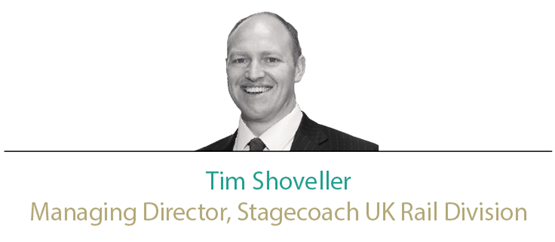
Rob certainly gives a straightforward account, and illustrates some of the challenges and opportunities that his role offers as a key leader in Network Rail, at this critical time for the railway.
Focusing first on the perpetual issue of NR’s organisation, Rob gives powerful examples of reasons for change. I would not disagree with any of the points made here to support the need for proper devolution, save for the major point on transforming the delivery, culture and economics of the industry. The feedback from passengers and stakeholders is clear - we need to be more radical and impatient.
The arguments are clearly made, my frustration is the lack of pace in progressing change. Remember that devolution was originally claimed to have been implemented by NR in all Routes in 2011, yet six years on authority is still not properly devolved.
Rob says: “It’s compounded by our legacy control hierarchy. Network Rail, quite rightly, does a lot of its assurance by control. It controls decisions centrally, and what that does is it makes the accountability difficult.”
I think Rob is being polite here. I am far from convinced that the current plans are sufficient, and the neutered authority of Route Managing Directors prevents the ownership and clarity that is evident in the TOC model, which has been very effective at driving down cost and improving safety (as noted in McNulty).
The new vision of further devolution is another step forward, but all this is taking too long. In the meantime, some very, very good NR employees are not able to contribute to their full potential, costs continue to rise, and opportunity is lost. Then there is the ultimate missed opportunity to improve the product we give our customers.
Moving on to the infrastructure itself, it was great to read Rob talking about the need for ‘system thinking’. I interpret this as meaning the ‘all the assets that create the system’, as opposed to the ‘whole railway network’.
I am convinced that the next tier of financial efficiency and service improvement will have to be led by ‘whole railway’ thinking - business cases that recognise the economic and safety impacts through the ‘railway system’, irrespective of owner or function. This does not mean that the organisation or ownership of the system has to be as one, but means very effective measures to align incentives and benefits. There is a big opportunity to do better in key safety capacity outputs to (in turn) improve the financial outcomes.
Recognising this and ensuring that all aspects are taken into account does allow a different view of priority, opportunity and aligns behaviours. This was, of course, a key element of Sir Roy McNulty’s report (some time before Shaw), yet we have not made sufficient progress in driving these changes to the incentives. CP6 is the next opportunity…
But sticking with the infrastructure. As Rob discusses, there has been progress here - driven by the first iteration of devolution - to develop a ‘local’ understanding of the condition of assets and how they work together at that location, with unique duty cycles and maintenance access to form the system.
How do we do better? In my view, it is no coincidence that the ‘total route modernisation’ approach has proved to deliver railways that provide excellent performance and customer delivery. I am convinced that ‘patch and mend’ just results in high costs of implementing schemes and does not deliver either performance or efficiency. Trying to interface modern technology into very old assets is like expecting something built when you listened to music on a gramophone to be compatible with an iPhone - it may be possible, but it’s not a good idea!
Which brings us to the challenges of running the LNE Route, critical to the success of the key Stagecoach Rail business of East Midlands Trains, Virgin Trains East Coast, and eventually Supertram’s operation to Rotherham.
Rob and his team certainly have their work cut out, but have worked hard to build positive relationships with the MDs of each business in what are clearly very challenging conditions. There is incredible diversity within the Route, and there is a lot to be done in order to allow the operators to deliver the promises that have been made to passengers, stakeholders and indeed the Treasury for the premia payments the Route enables. Taxpayers also stand to earn a huge benefit from franchise premia linked to the route. NR’s stewardship of the infrastructure is central to making that happen.
His illustration of the problems at King’s Cross are very honest. No one likes to be in this position, as the improvements are badly needed with significant passenger growth forecast based on the benefit from King’s Cross and the other schemes highlighted. Delay will reduce passenger revenue growth and cost the industry dear in the long run. It will also drive operating costs for the Route that were not budgeted to keep the old system running safely and reliably, so it’s bad news all round. But these are the decisions that need to be made locally, and one must respect Rob’s decision.
Perhaps of even greater concern is that King’s Cross is not alone, with other schemes being deferred for cost reasons. The early years of CP6 will have very large boxes at Feltham and Birmingham New Street, along with King’s Cross, all overdue. This is where the national co-ordination is necessary, and quickly! The ability to manage the scheme’s development and the supply chain’s capacity to respond to this challenge will be a major factor in the success (or otherwise) of 2019-20!

It is fascinating to read Rob’s comments on where Network Rail has got to in its journey to devolution - a journey that has been seriously underway now for a good four years, underlining the relatively slow pace of change in such a large, complex
organisation. Despite the time taken so far, and the progress made, there is clearly still a long way to go both organisationally and culturally before a truly devolved route (or collection of routes) is in place.
Rob highlights very well the difficulty in pinning down who is Network Rail’s true customer. In truth, there are many - stakeholders, funders, train operators, lineside neighbours, regulator (the list goes on) - but ultimately it is the fare-paying passenger or freight forwarder who will be the real judge of whether the important changes that need to happen have worked or not.
There is much in what Rob says that is absolutely spot-on, including: the importance of delivering today’s railway safely and punctually in order to earn the right for future investment; the need for looking at the asset as a system as opposed to disparate individual items (and progressing the ‘flight engineer’ role to improve reliability); the importance of getting the early specification and design stages of projects right; and the challenge of dispersing the ‘accountability fog’.
From my own dealings with his route, Rob has already instilled a very customer-focused culture, one in which his team is keen to understand and respond to the needs of operators, and to find a way of delivering those effectively. We’ve seen this with the impressive response when we moved the Sleeper service to King’s Cross during the Lamington Viaduct closure, and we are seeing it again as we discuss our strategic plans with Rob and his team.
How the organisation is structured to respond to the many competing priorities, and to deliver what is affordable to time,and to budget, remains a challenge. It’s all too easy to be distracted by internal matters, and to lose sight of the needs of the end customer (of whatever shade).
With the potential creation of a Northern route, and the other structural changes to achieve more devolution to routes along with the setting-up of the system authority role, there is much to occupy and possibly distract the time and energy of Network Rail colleagues. And so it is essential that any change is delivered swiftly and with as little impact on customers as possible.
But the changes do need to happen, particularly to make it easier for potential funders to invest in the rail network and thus achieve their objectives. Traditionally, third party investment in the network that has actually resulted in change ‘on the ground’ has often felt that it happened despite the best efforts of the industry to prevent it!
It’s interesting to consider Rob’s observations on the culture of being ‘done to’ in the routes - being told what to do and how to do it (and success being measured by compliance in this respect), as opposed to being able to develop and deliver better ways of doing things locally. Being involved in trying to deliver this sort of change in the earliest days of devolution, immediately after the era of ‘command and control with an iron grip’, it was always evident to me that for many people, simply complying with a set of instructions on how to do things was actually easier and less risky than being challenged to find ways of delivering differently.
The comfort zone of layers of bureaucracy, with little individual accountancy, requires strong leadership and support to break out of, so that colleagues at all levels can believe they can make a difference and do things better. Encouraging people to have a mindset that says they can challenge standards, challenge processes, challenge costs and timescales, to find better ways of doing things, is of paramount importance if we are to justify and afford the investment which the network so clearly needs.
Achieving this change in people’s mindset is perhaps the greatest challenge – and the greatest opportunity - that we face to really transform delivery, be it the day-to-day railway or the range of investment programmes needed to cope with growth. Identifying some ‘quick wins’ which demonstrate that this approach works should help to build the momentum.
However, alongside the need for truly devolved routes with empowered teams, there will also be a need for the ‘national’ picture to remain joined-up and co-ordinated - not only because most train operators run over more than one route, and so require a high degree of consistency in how they interact with routes, but also because of the number of ‘national’ programmes that will continue to affect what goes on in any specific route.
This will perhaps be the biggest challenge of devolution: balancing the different needs and priorities of each devolved (and individually regulated) route with the bigger picture of ‘one network’ and operators who run over several routes. Rob’s description of how he is reviewing the ETCS programme for the East Coast Main Line is a good example of how this can work.
There is also a need to be able to capture the best ways of doing things and transfer these effectively between routes. No doubt route-based regulation will provide a sharper focus on the differences between routes, and encourage competition as well as co-operation between routes to the benefit of the wider industry.
Historically, it’s been all too easy to try to explain away differences in costs because each route is ‘unique’, with its own peculiar set of geographical, customer or historic challenges which are used to explain away variances in unit rates. And while this is true to an extent, as Rob highlights (citing the lack of ECML investment in recent years as an example), the more these differences are exposed and properly understood the more chance we have of improving. Perversely, making the routes much more separate as entities may well be the key to delivering more efficiency and consistency, if this challenge is properly embraced!
The Route MD role can feel like a massive plate-spinning exercise. The long list of competing priorities, different customer needs and impatient stakeholders, along with the normal day-to-day challenges, shows no signs of letting up. But this is all about how we move forward as an industry, and the potential which is there to make the changes to deal with the growth which is coming.
It’s really encouraging to read his views on how he is going to achieve this on LNE and East Midlands, and the positive changes which he has already made. I wish him and his team the best of luck as they grasp the opportunities which are so clearly there.

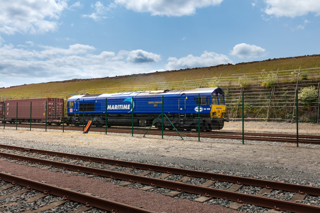
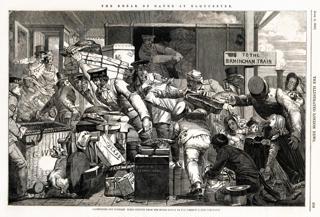
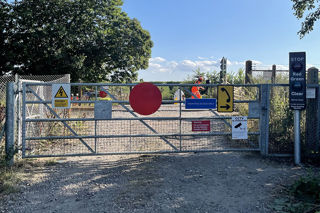
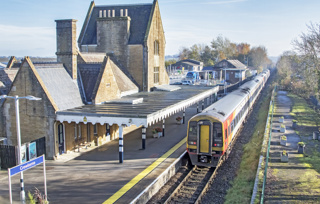
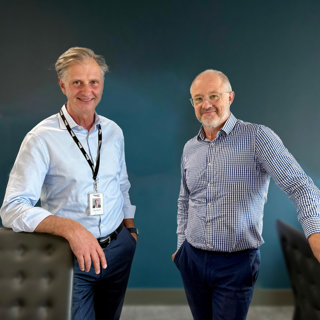

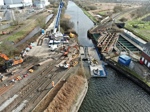







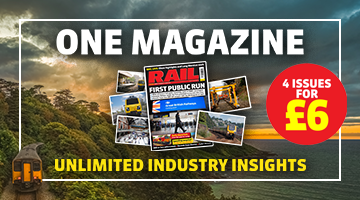

Login to comment
Comments
No comments have been made yet.